What are stockings made from? The simple answer is nylon and spandex. Pick a stockings pack and check the content part, you will find these 2 words. Do we use these two materials from the beginning? Or in other words, what about the history for material used for stockings? Let’s hear this from Thriving, the leading stockings manufacturer in China.
Ancient time
Before people invented nylon and spandex, silk and linen are the main materials for stockings. Obviously only rich class especially royal members can afford silk. The earliest picture proof for silk stockings(called Chausses at the moment) , is in Charlemagne period, more than 1300 years ago.

Men loved stockings more than women
Modern Times
Dr. Carothers invented in 1935 in Dupont. An interesting thing is that originally it was not invented for stockings. Guess what it is? Toothbrush! See the below advertisement. People treated this new nylon brush as a great invention!
 First nylon toothbrush ads in 1938
First nylon toothbrush ads in 1938
However, due to its unprecedented lightness and elasticity, nylon soon became the new generation of material for stockings. All ladies were crazy for this new substitute of silk. When supply of nylon can not meet the needs due to world war II, that was how nylon riots happened.(more details in https://en.wikipedia.org/wiki/Nylon_riots )
In 1959, spandex stepped onto the stage. Compared to nylon, it had more elasticity . This would bring the needed comfort for ladies. You may find this hard to believe. In memory, nylon seems to have sufficient elasticity. Here is an old video for your understanding.
1959’s video about pure nylon stockings
If you are observant, you should have found somethings. In the video, these stockings of pure nylon are not as stretchy as today’s ones in the market. They were very durable. However, they also look quite rigid with pretty little elasticity. That is why we say spandex’s role in stockings are quite important.
There is also another interesting story from the video. It is about stockings and pantyhose. Stockings are in 2 separate legs. This is the basic construction from its birth. Pantyhose are two legs sewn together. It didn’t come out untill 1959, Allen Gant made the first pair of pantyhose(called panti-legs at that time) for his preganant wife. Pantyhose became extremely popular in 1960s. At that time, mini skirt was the pop culture and pantyhose can provide better coverage.
 Girls in mini skirts and pantyhose in 1964
Girls in mini skirts and pantyhose in 1964
The Recent 50 Years
Nowadays, more than 80% of stockings in the market are pantyhose. From this angel, it is not accurate to use stockings to call all of the products. Especially when you are talking a pair of pantyhose.
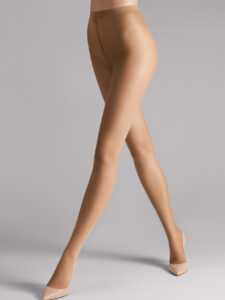 A pair of pantyhose from Wolford
A pair of pantyhose from Wolford
The last invention of yarns in stockings happened in Japan. Before that time, stockings manufacturer used nylon and spandex separately for stockings production. Hori Rukusuke, founder of ATSUGI, designed a machine that can combine the two yarns into one yarn before feeding them into the knitting machine. This is covered yarn! It can greatly improve the quality of stocking. From then on, covered yarn became the main material format. A bit more introduction to ATSUGI brand. It is still one of the leading stockings brands today. ATSUGI is also the partner of Thriving who is the leading stockings manufacturer in China, created covered yarn.
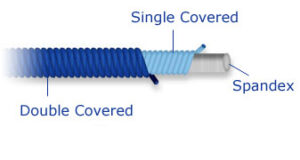 Covered yarn is 1 spandex inside with 1 or 2 nylon yarns wrapping outside.
Covered yarn is 1 spandex inside with 1 or 2 nylon yarns wrapping outside.



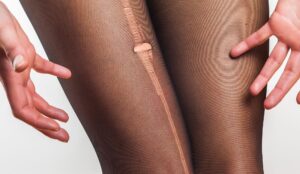
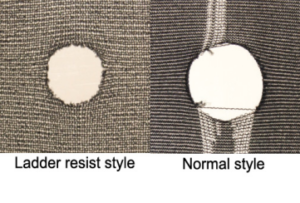 Choosing the right fabric is the first step. Next move is to find the way of creating suitable shape for head and neck. It is not that easy to just knit a piece of stockings leg and used that as extra layer. “That will be just suitable for bank robbing!” Lee laughed for his explanation. “The volume of a leg is not large enough for head especially for a comfortable fitting to rider’s head. Therefore, we need to find other ways.”
Choosing the right fabric is the first step. Next move is to find the way of creating suitable shape for head and neck. It is not that easy to just knit a piece of stockings leg and used that as extra layer. “That will be just suitable for bank robbing!” Lee laughed for his explanation. “The volume of a leg is not large enough for head especially for a comfortable fitting to rider’s head. Therefore, we need to find other ways.”
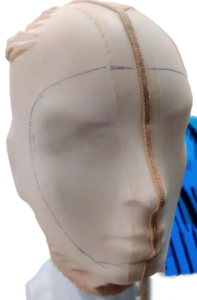 A new issue soon came to the table after trials. The extra layer was not able to bring enough air flow. Rider even felt the fabric was sticked to face more than the orginal foam surface. Lee put it on himself and tested the function in running for couple of times. Very quickly he figured out the reason. stockings were usually dyed with silicone softener for soft touch effect. However, in this layer product, silicone becomes a barrier for air flow as it created an invisible wall on the surface. By changing to a new eco-softener, Lee finally made the fabric effective for its designed function.
A new issue soon came to the table after trials. The extra layer was not able to bring enough air flow. Rider even felt the fabric was sticked to face more than the orginal foam surface. Lee put it on himself and tested the function in running for couple of times. Very quickly he figured out the reason. stockings were usually dyed with silicone softener for soft touch effect. However, in this layer product, silicone becomes a barrier for air flow as it created an invisible wall on the surface. By changing to a new eco-softener, Lee finally made the fabric effective for its designed function.